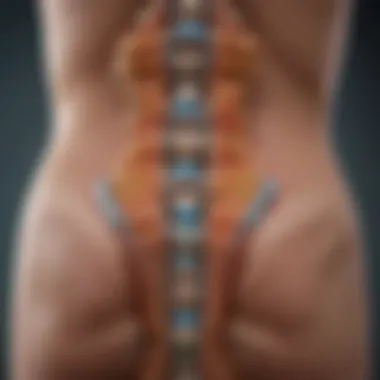Unraveling the Complexities of Back Pain When Sleeping: Causes and Solutions


Workout Tips
Introduction
Back pain when sleeping is a prevalent issue that many individuals face, often leading to discomfort and disrupted sleep patterns. Understanding the underlying reasons for back pain during restful hours is crucial for improving overall sleep quality and reducing discomfort. By exploring the various factors contributing to back pain at night, individuals can gain valuable insights to address and prevent this common issue.
Exploring the Mystery of Back Pain at Night
Impact of Sleep Position
When it comes to back pain during sleep, the position in which one sleeps plays a significant role. The alignment of the spine while sleeping can either alleviate or exacerbate back pain. For example, sleeping on the back with proper spinal alignment can relieve pressure on the lower back, promoting better rest. Understanding the impact of sleep position on back pain is essential for choosing the most suitable position to enhance sleep quality.
Role of Mattress and Pillow
The choice of mattress and pillow can greatly influence back pain experienced during sleep. A mattress that provides adequate support and cushions pressure points can help maintain spinal alignment, reducing the risk of discomfort. Similarly, selecting the right pillow to support the neck and enhance sleep position is crucial for alleviating back pain. Considering the role of mattress and pillow in managing back pain is vital for creating a conducive sleep environment.
Underlying Health Conditions
Apart from sleep position and bedding accessories, underlying health conditions can also contribute to back pain at night. Health issues such as sciatica, degenerative disc disease, or muscle strain can exacerbate discomfort during sleep. Understanding the impact of these health conditions on back pain can guide individuals in seeking appropriate medical interventions and lifestyle modifications to manage and alleviate nighttime discomfort.
In summary, exploring the mystery of back pain at night involves understanding the influence of sleep position, the significance of mattress and pillow selection, and the role of underlying health conditions. By delving deeper into these aspects, individuals can gain insights to personalize their sleep environment and habits to achieve a restful night's sleep.
Understanding Sleep Position
Sleep position plays a crucial role in maintaining spinal alignment and overall comfort during rest. In this article, we delve into the significance of understanding sleep position to address back pain issues that arise when sleeping. By focusing on specific elements like proper spinal alignment, pillow height importance, and considerations about different sleeping positions, readers can gain valuable insights to enhance their quality of sleep.
Back Sleeper
Proper Spinal Alignment:


Proper spinal alignment is essential for back sleepers as it helps distribute body weight evenly and reduce pressure on the spine. The key characteristic of proper spinal alignment lies in maintaining the natural curve of the spine while sleeping. This alignment is a popular choice for back sleepers as it promotes a neutral posture and minimizes the risk of discomfort or pain. The unique feature of proper spinal alignment is its ability to support the back's natural curvature, aiding in a more restful and rejuvenating sleep experience.
Pillow Height Importance:
The importance of pillow height for back sleepers cannot be overstated. Optimal pillow height ensures that the head and neck are aligned with the spine, preventing strain on neck muscles and promoting comfortable sleep. The key characteristic of pillow height importance lies in providing adequate support to maintain proper spinal alignment throughout the night. This aspect is a beneficial choice for back sleepers as it helps prevent stiffness and soreness, enhancing overall sleep quality. The unique feature of recognizing the ideal pillow height contributes significantly to a peaceful and uninterrupted night's rest.
Side Sleeper
Supporting Hips and Shoulders:
For side sleepers, supporting hips and shoulders is vital to prevent discomfort and pain. The key characteristic of this aspect involves choosing a mattress and pillow that contour to the body's natural curves, alleviating pressure points and ensuring proper alignment. This approach is a popular choice for side sleepers as it enhances comfort and reduces the risk of muscle strain or misalignment. The unique feature of adequately supporting hips and shoulders results in a more comfortable and undisturbed sleep for individuals who prefer this position.
Optimal Pillow Firmness:
Optimal pillow firmness is crucial for side sleepers to maintain proper spinal alignment and prevent neck strain. The key characteristic of choosing the right pillow firmness lies in providing adequate support while allowing the head to rest comfortably. This choice is beneficial for side sleepers as it helps cushion the head and neck, reducing the chances of waking up with stiffness or pain. The unique feature of optimal pillow firmness ensures a peaceful and uninterrupted night's sleep for individuals who favor sleeping on their side.
Stomach Sleeper
Neck Strain Risks:
Stomach sleepers often face neck strain risks due to the prolonged rotation of the head. The key characteristic of addressing neck strain risks involves using a thin pillow or no pillow at all to maintain a more natural neck position during sleep. This approach is beneficial for stomach sleepers as it minimizes the chances of strain or discomfort in the neck area, promoting better alignment and comfort. The unique feature of mitigating neck strain risks contributes significantly to enhancing the quality of sleep for individuals who prefer sleeping on their stomach.
Effect on Spinal Health:
The effect of sleeping on the stomach can impact spinal health by increasing the risk of overarching the lower back and straining the neck. The key characteristic of considering this effect lies in recognizing the need for additional support to maintain neutral alignment while sleeping. This choice is beneficial for stomach sleepers as it helps reduce pressure on the spine and promote better posture during rest. The unique feature of understanding the effect on spinal health leads to a more comfortable and supportive sleeping environment, minimizing the potential for back pain issues and discomfort.
The Mattress Factor
A key element to consider in the mattress factor is the firmness level. The firmness of a mattress impacts how well it supports your body and helps maintain proper spinal alignment while you sleep. Finding the right firmness level that suits your sleeping position is essential for reducing the risk of back pain and enhancing your overall sleep quality.


Firmness Level
Matching to Sleep Position
Matching the firmness of your mattress to your preferred sleep position is critical for ensuring proper spine alignment and minimizing back pain. Each sleep position requires a specific level of firmness to provide adequate support and comfort. For example, back sleepers typically benefit from medium to firm mattresses to support the natural curve of the spine.
Impact on Spinal Alignment
The firmness level of your mattress directly influences your spinal alignment while you sleep. A mattress that is too soft or too firm can lead to misalignment of the spine, contributing to back pain over time. Optimal spinal alignment during sleep helps reduce pressure points and allows your muscles to relax, promoting a more restful sleep experience.
Material Composition
Memory Foam Benefits
Memory foam mattresses offer unique benefits for back pain sufferers. The contouring properties of memory foam help distribute body weight evenly, reducing pressure on the spine and promoting better alignment. Additionally, memory foam adjusts to your body shape, providing personalized support where needed most.
Innerspring Support
Innerspring mattresses are known for their bouncy feel and exceptional support. The interconnected coils in an innerspring mattress offer responsive cushioning and help maintain spinal alignment during sleep. The sturdy support of innerspring mattresses can be beneficial for individuals with back pain, especially those who prefer a more traditional mattress feel.
Effective Pillow Selection
Choosing the Right Pillow
Neck Support Importance
Neck Support Importance plays a pivotal role in ensuring optimal spinal alignment and reducing strain on the neck muscles. A pillow that offers adequate neck support helps maintain the natural curve of the cervical spine, preventing stiffness and discomfort. The key characteristic of Neck Support Importance lies in its ability to cradle the neck and head comfortably, promoting a neutral position during sleep. This feature is particularly beneficial for individuals experiencing back pain when sleeping, as it minimizes pressure on the neck and upper spine, allowing for proper rest and relaxation.
Adjustability for Comfort


Adjustability for Comfort refers to the pillow's ability to cater to individual preferences and sleeping positions. Pillows with adjustable loft or firmness levels enable users to customize their sleeping experience for maximum comfort. The key characteristic of Adjustability for Comfort is its versatility in accommodating different sleep styles and body types. This feature allows users to fine-tune the pillow to meet their specific needs, whether they prefer a softer or firmer surface. While adjustable pillows offer personalized comfort, they may require some experimentation to find the perfect setting for a restful night's sleep.
In this segment, we will delve into the crucial topic of combatting health conditions related to back pain during sleep. It is essential to address these health issues as they can significantly impact the quality of sleep and overall well-being. By understanding and effectively managing these conditions, individuals can experience a considerable improvement in their sleep quality and daily life.
Spinal Issues
Sciatica and Nerve Pain
Sciatica and nerve pain play a significant role in contributing to back pain during sleep. These conditions can lead to persistent discomfort and affect an individual's ability to rest properly. Sciatica is characterized by sharp, shooting pain that radiates along the sciatic nerve, often originating from the lower back down through the leg. Dealing with sciatica requires a comprehensive approach that may involve pain management techniques, physical therapy, and lifestyle modifications. While challenging, addressing sciatica effectively can lead to reduced pain levels and improved sleep quality for those affected by this condition.
Degenerative Disc Disease
Degenerative disc disease is another prevalent issue contributing to back pain. This condition involves the breakdown of intervertebral discs in the spine, leading to pain, stiffness, and reduced flexibility. Individuals with degenerative disc disease may experience increased discomfort during sleep due to lack of proper support and alignment. Managing this condition often revolves around strengthening the surrounding muscles, improving posture, and implementing ergonomic changes to alleviate pressure on the spine. By carefully addressing degenerative disc disease, individuals can experience enhanced comfort during sleep and reduced instances of back pain.
Muscle Strain
Importance of Stretching
Stretching plays a vital role in preventing and managing muscle strain, which can significantly impact back pain during sleep. Regular stretching exercises can improve flexibility, reduce muscle tension, and enhance blood circulation, promoting relaxation and alleviating discomfort. Incorporating targeted stretches into a daily routine can help increase muscle strength and mobility, reducing the risk of strain and supporting proper spinal alignment for better sleep quality.
Posture Correction
Proper posture is paramount in combating back pain, especially when sleeping. Posture correction focuses on maintaining the natural alignment of the spine to reduce pressure on the muscles and joints. Poor posture during sleep can lead to increased strain on the back, contributing to discomfort and disrupted sleep patterns. By consciously adjusting and improving sleep posture, individuals can mitigate the risk of back pain and enhance overall sleep quality. Implementing specific posture correction techniques can promote better spinal alignment and support during sleep, leading to a more rejuvenating rest.
Conclusion
Back pain while sleeping is a prevalent issue that affects numerous individuals, impacting their overall quality of life. The significance of addressing this concern cannot be overstated, as uninterrupted sleep is vital for physical and mental well-being. By gaining insights into the potential causes of back pain during sleep and implementing effective strategies to alleviate discomfort, individuals can experience a restful and rejuvenating night's rest.
Enhancing Sleep Quality
Implementing Changes
Implementing changes in sleep habits and environment plays a pivotal role in enhancing sleep quality and mitigating back pain. By focusing on crucial aspects such as sleep position, mattress firmness, and pillow support, individuals can optimize spinal alignment and alleviate pressure points. Adjusting these factors to suit personal preferences and body requirements can lead to improved sleep efficiency and overall well-being. Implementing changes tailored to individual needs ensures a customized approach to sleep improvement, fostering long-term benefits and promoting better health outcomes.
Consulting Healthcare Professionals
Consulting healthcare professionals is an essential step in managing back pain during sleep effectively. By seeking guidance from medical experts, individuals can receive personalized advice and treatment options tailored to their specific conditions. Healthcare professionals can conduct thorough assessments to identify underlying factors contributing to back pain and recommend targeted interventions. Collaborating with healthcare providers fosters a holistic approach to sleep health, ensuring comprehensive care and optimal outcomes. While consulting healthcare professionals may involve additional steps, the benefits of expert guidance and support in overcoming back pain-related sleep disruptions are invaluable.







